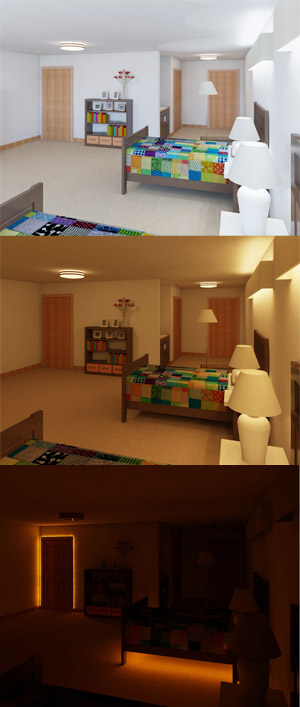Older adults in long-term care facilities often spend their days and nights in dimly-lit rooms with minimal time spent outdoors. The constant, unvarying dim light found in many long-term care facilities means that older adults are not experiencing the robust daily patterns of light and dark that synchronize the body’s circadian clock to local sunrise and sunset. Disruption of this 24-hour rhythm of light and dark affects every one of our biological systems from DNA repair in single cells to melatonin production by the pineal gland, to electrical activity in the brain.
 |
|
Different lighting settings and modes suggested by LRC's online interactive lighitng design website. (Photo courtesy of LRC) |
Circadian disruption is most obviously linked with disruption of the sleep-wake cycle—feeling sleepy during the day and experiencing sleep problems such as insomnia at night—but is also linked with increased risk for diabetes, obesity, cardiovascular disease and cancer. Sleep problems are all too common among older adults, especially those in long-term care facilities, yet sleep could not be more important to their overall health and wellbeing. In fact recent research has shown that poor sleep may directly impact the onset and progression of Alzheimer’s disease, and conversely, healthy sleep may prevent or slow progression of the disease.
A team of researchers at the Lighting Research Center (LRC) at Rensselaer Polytechnic Institute have created a portfolio of lighting patterns, available via interactive website, to help lighting and healthcare professionals to select and place luminaires to support circadian health and wellbeing, while supporting the vision and orientation needs of older adults. The patterns are based upon the 24-hour lighting scheme for older adults proposed by LRC Professor Mariana Figueiro in 2008, which recommends cycled electric lighting with cool, high light levels for high circadian stimulation during the daytime, and warm, low light levels for reduced circadian stimulation in the evening, along with good lighting for visibility, and nightlights to provide horizontal/vertical cues to improve postural control and stability.
“Older adults in these dimly-lit facilities typically do not experience the robust light-dark pattern necessary to keep their circadian systems entrained to a regular sleep-wake cycle,” said Figueiro. “Our new website shows examples of how long-term care facilities can utilize lighting to support the health and wellbeing of their residents.”
The new website—Lighting Patterns for Healthy Buildings—is designed in the spirit of traditional architectural pattern books, presenting model designs for typical rooms that can be adapted to specific buildings and styles. The second phase of the project will showcase healthy lighting for children and adolescents in schools.
Like older adults in long-term care facilities, many of our nation’s children are spending their days in dimly-lit classrooms, not receiving the robust circadian stimulus necessary for circadian entrainment, leading to decrements in sleep and mood, reduced performance in school, and increased risk of diabetes and obesity.
The project was led by LRC researchers Mariana Figueiro, Kassandra Gonzales, and Russ Leslie, and was sponsored by the Light & Health Alliance: Acuity Brands, Cree, GE Lighting, Ketra, OSRAM Sylvania, Philips Lighting, Sharp, and USAI Lighting.
“The simple lighting solutions we recommend can have a profound impact on health and wellbeing,” said Leslie.












